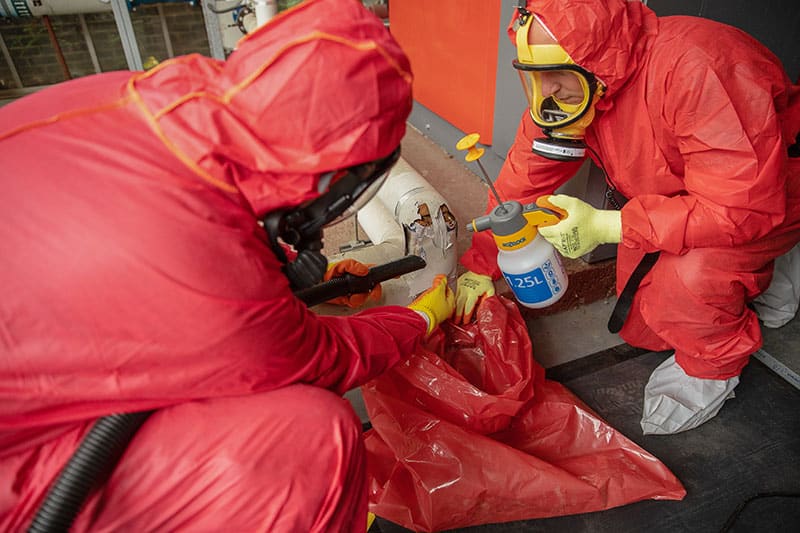What qualifications do I need for asbestos removal?
Regrettably, while the importation and use of asbestos in the UK has been banned since 1999, there has never been any legislation in the UK demanding that asbestos is removed from buildings in any and all areas where this notoriously carcinogenic material is still present.
For this reason, even in the 2020s, there remains an asbestos management and removal industry that is dedicated to ensuring all the right steps are taken in relation to any asbestos that might still exist on a given premises.
As asbestos was once widely used in the UK construction industry, there are many asbestos products that are still present in buildings across the country that date from before the year 2000. In some cases, asbestos-containing materials (ACMs) may have deteriorated or over time, or they may be in a location where they could be especially susceptible to disturbance.
In the event that such disturbance does occur, or if loose asbestos fibres are otherwise released from ACMs, these could subsequently be breathed in or ingested by someone nearby. This, in turn, could lead to a heightened risk of the development of a potentially fatal asbestos-related disease, such as mesothelioma or asbestos-related lung cancer, even decades after the exposure occurred.
So, you can probably begin to see why, in some cases, the decision may be made to remove certain asbestos materials from a given site, instead of leaving it in place. But with it being crucial to follow all the proper procedures for asbestos removal, how can you be sure that you have the right qualifications to remove asbestos from a particular premises?
Understanding asbestos removal
At this point, you might be thinking: if asbestos is so dangerous (and it is indeed estimated to still cause around 5,000 deaths a year in the UK), is it even legal to carry out asbestos removal yourself?
In order to answer this question, it is important to understand the Health and Safety Executive (HSE) licensing regime that exists in relation to asbestos in the UK. Essentially, some forms of work with asbestos are classified as ‘non-licensed’ – meaning a licence from the HSE isn’t needed in order to carry it out – whereas some other forms of asbestos work are ‘licensed’.
As we explain in our comprehensive guide to the differences between licensed and non-licensed asbestos removal, there are certain requirements that the HSE sets out for work to be categorised as ‘licensed’ or ‘non-licensed’.
The only circumstances in which asbestos removal work would not require a licence, would be if the work is sporadic and of low intensity, in addition to being carried out in such a way that workers’ exposure to asbestos does not exceed the legal control limit.
For the given asbestos removal work to be non-licensed, it will also be necessary for the asbestos fibres to be firmly contained within a matrix, with the asbestos also being in a reasonable condition, and the person undertaking the removal not deliberately attempting to break up the ACMs.
As you can see, then, there is a lot of scope for asbestos removal to require an HSE licence. Such work will be licensable when the work to be carried out is not sporadic or of low intensity, and when the risk assessment is unable to clearly demonstrate that the control limit will not be exceeded.
With the UK today having stringent regulatory requirements in relation to how asbestos is managed on a given site – as set out by legislation such as the Control of Asbestos Regulations 2012 (CAR 2012) – it is of critical importance to make sure you comply with the licensing requirements.
Types of courses available
When it comes to training courses in relation to asbestos, there are three broad categories: asbestos awareness; non-licensable work with asbestos, including Notifiable Non-licensed Work (NNLW); and licensable work with asbestos.
For the purposes of asbestos removal, we can put to one side the first of those categories, given that asbestos awareness training focuses on providing workers and supervisors with the information that they require in order to avoid work that may disturb asbestos. It is not, in other words, training for workers who intend to carry out work that will disturb ACMs.
So, let’s explain those other two categories of training course, with regard to asbestos removal:
Licensed asbestos removal courses
Asbestos licensed training is also often referred to as category C, or Cat C training. The exact time that it takes to deliver this type of training will depend on the course provider, but if the course provider is accredited with the United Kingdom Asbestos Training Association (UKATA), three days of training is typical for the asbestos licensed training that basic operatives or supervisors require.
The HSE sets out more information about what asbestos licensed training is required to consist of, in its HSG247 Asbestos: The licensed contractors’ guide document.
As a general rule, though, a licensed asbestos removal course should cover all the same elements that are required for asbestos awareness training and asbestos non-licensed training, in addition to some further aspects.
Those additional required aspects include such subjects as the construction of a work enclosure; the setting-up of the site encompassing barriers, transit routes, and waste storage areas; and decontamination procedures within airlocks, enclosures, and decontamination units.
The course should also provide information on controlled removal techniques and how they work, covering aspects such as types of wet surfactants and injection.
Non-licensed asbestos removal courses
As the name suggests, non-licensed asbestos training is designed for those who will be involved with non-licensed asbestos work – in other words, asbestos work that can be carried out without the need for a licence from the HSE.
Non-licensed asbestos training – which is also known as Cat B, or category B training – typically covers a range of topics that are also addressed by licensed, or Cat C training.
Those elements that you can expect a Cat B training course to include encompass the likes of the control limit and the importance of air monitoring; safe work practices; the correct use and maintenance of control measures; the purpose, selection, and limitations of respiratory protective equipment (RPE); decontamination procedures; waste handling procedures; and much more.
Above, we referred to Notifiable Non-licensed Work, or NNLW. This term refers to circumstances where work carried out on licensed asbestos materials is judged to be sufficiently low-risk to not require notification to the HSE. Sure enough, non-licensed asbestos training also includes the training that is required in order to undertake NNLW.
Qualifications obtained
If it is a qualification for licensed asbestos removal that you are interested in obtaining, the most common qualification for this is the RSPH Level 2 NVQ Diploma in Removal of Hazardous Waste (Construction) – Licensed Asbestos.
Acquiring this diploma will enable you to carry out large asbestos removal projects, encompassing such processes as the removal of enclosures, the removal of the asbestos itself, the packing and disposal of asbestos, and the fulfilment of the cleaning and decontamination requirements for this type of work.
The qualifications that one can gain for non-licensed asbestos work are somewhat more limited in their scope, but nonetheless certify the user to carry out small, low-risk asbestos removal tasks. You might undertake such a course as a starting point for learning about asbestos removal, before you proceed to take on licensed asbestos training.
It is worth noting that there is no legal requirement for employees to hold a particular certificate of training before they are permitted to carry out asbestos work. Many providers of asbestos training do issue certificates, but these do not constitute proof of the holder’s competency to do the job; they merely show that the given individual has undergone training.
Importance of proper asbestos removal training
With asbestos presenting such a potentially serious risk to health in the event of any disturbance being caused to ACMs and loose asbestos fibres being released, it cannot be emphasised enough, how important it is to undergo proper training if you intend to carry out asbestos removal work.
The HSE’s stance on asbestos has long been – and continues to be – that as long as the substance is in good condition and has not been disturbed or damaged, it presents negligible risk to health. For this reason, building owners have often made the decision to not remove asbestos from their premises, instead determining it to be a safer course of action to manage the material in place.
In some circumstances, however, in which the material is assessed as posing a particular risk if it is left alone, the decision is made to remove it. By carrying out the right training for asbestos removal – whether licensed, non-licensed, or both – you will be able to better ensure both safety and compliance from the start to finish of this highly sensitive and potentially hazardous task.
Recommendations and tips when looking at asbestos removal courses
With there being so many providers of asbestos removal training courses out there, it is important to do your research when you are attempting to find the most suitable course and provider.
This may include looking out for a course provider that is accredited by a reputable external body, such as the United Kingdom Asbestos Training Association (UKATA).
With the exact content of asbestos removal courses liable to vary from one training specialist to the next, it is also important to carefully scrutinise this for whatever course provider you may have in mind, in the context of what your practical needs are for asbestos removal.
If the given individual who has undergone training will not merely be carrying out asbestos removal on a one-off basis, but will be undertaking multiple similar tasks over time, it is also important to be mindful of the need to stay updated on the regulations.
So, you may need to arrange for further ongoing education and re-certification, not least so that you can be kept informed of any relevant changes in regulations and industry standards.
Conclusion: the right asbestos removal training will be vital to ensuring safety and compliance
Undergoing proper training in asbestos removal will be of critical importance to ensuring that any such work you carry out is done in the safest possible manner, in compliance with relevant regulations in the UK.
Hopefully, this guide will have helped you to feel more confident about the process of researching and comparing asbestos removal training courses, and deciding on the one that represents the optimal match to your own requirements.
If you are in need of any of a range of asbestos management and/or removal services from a widely trusted, licensed, and accredited organisation, please don’t hesitate to reach out to Oracle Solutions today for your fast and free quote.

Written by Callum McDonald
Callum McDonald is an expert in asbestos quality management, ensuring rigorous adherence to regulations and high-quality standards in removal projects. His focus on enhancing quality and client satisfaction makes him a crucial asset in safety and compliance within the field. Callum's expertise in technical support and oversight of licensed works underscores his commitment to excellence in asbestos management, providing invaluable guidance to clients in this specialised area.

